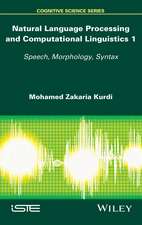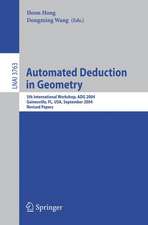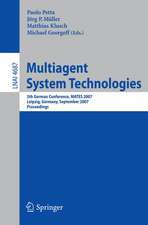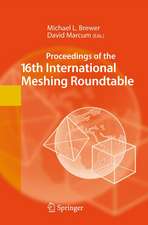Prediction and Classification of Respiratory Motion: Studies in Computational Intelligence, cartea 525
Autor Suk Jin Lee, Yuichi Motaien Limba Engleză Paperback – 27 aug 2016
This book presents a customized prediction of respiratory motion with clustering from multiple patient interactions. The proposed method contributes to the improvement of patient treatments by considering breathing pattern for the accurate dose calculation in radiotherapy systems. Real-time tumor-tracking, where the prediction of irregularities becomes relevant, has yet to be clinically established. The statistical quantitative modeling for irregular breathing classification, in which commercial respiration traces are retrospectively categorized into several classes based on breathing pattern are discussed as well. The proposed statistical classification may provide clinical advantages to adjust the dose rate before and during the external beam radiotherapy for minimizing the safety margin.
In the first chapter following the Introduction to this book, we review three prediction approaches of respiratory motion: model-based methods, model-free heuristic learning algorithms, and hybrid methods. In the following chapter, we present a phantom study—prediction of human motion with distributed body sensors—using a Polhemus Liberty AC magnetic tracker. Next we describe respiratory motion estimation with hybrid implementation of extended Kalman filter. The given method assigns the recurrent neural network the role of the predictor and the extended Kalman filter the role of the corrector. After that, we present customized prediction of respiratory motion with clustering from multiple patient interactions. For the customized prediction, we construct the clustering based on breathing patterns of multiple patients using the feature selection metrics that are composed of a variety of breathing features. We have evaluated the new algorithm by comparing the prediction overshoot and thetracking estimation value. The experimental results of 448 patients’ breathing patterns validated the proposed irregular breathing classifier in the last chapter.
| Toate formatele și edițiile | Preț | Express |
|---|---|---|
| Paperback (1) | 639.72 lei 43-57 zile | |
| Springer Berlin, Heidelberg – 27 aug 2016 | 639.72 lei 43-57 zile | |
| Hardback (1) | 645.97 lei 43-57 zile | |
| Springer Berlin, Heidelberg – 12 noi 2013 | 645.97 lei 43-57 zile |
Din seria Studies in Computational Intelligence
- 20%
 Preț: 449.37 lei
Preț: 449.37 lei - 20%
 Preț: 1158.26 lei
Preț: 1158.26 lei - 20%
 Preț: 986.66 lei
Preț: 986.66 lei - 20%
 Preț: 1452.76 lei
Preț: 1452.76 lei - 20%
 Preț: 168.78 lei
Preț: 168.78 lei - 18%
 Preț: 1112.30 lei
Preț: 1112.30 lei - 20%
 Preț: 565.38 lei
Preț: 565.38 lei - 20%
 Preț: 649.28 lei
Preț: 649.28 lei - 20%
 Preț: 1047.73 lei
Preț: 1047.73 lei - 20%
 Preț: 1578.96 lei
Preț: 1578.96 lei - 20%
 Preț: 643.50 lei
Preț: 643.50 lei - 20%
 Preț: 657.49 lei
Preț: 657.49 lei - 20%
 Preț: 993.28 lei
Preț: 993.28 lei - 20%
 Preț: 990.80 lei
Preț: 990.80 lei - 20%
 Preț: 989.96 lei
Preț: 989.96 lei - 20%
 Preț: 1165.69 lei
Preț: 1165.69 lei - 20%
 Preț: 1444.52 lei
Preț: 1444.52 lei - 20%
 Preț: 1041.96 lei
Preț: 1041.96 lei - 20%
 Preț: 1047.73 lei
Preț: 1047.73 lei - 20%
 Preț: 1046.06 lei
Preț: 1046.06 lei - 18%
 Preț: 2500.50 lei
Preț: 2500.50 lei - 20%
 Preț: 989.13 lei
Preț: 989.13 lei - 20%
 Preț: 1165.69 lei
Preț: 1165.69 lei - 20%
 Preț: 1164.05 lei
Preț: 1164.05 lei - 20%
 Preț: 1042.79 lei
Preț: 1042.79 lei - 20%
 Preț: 1460.19 lei
Preț: 1460.19 lei - 18%
 Preț: 1403.52 lei
Preț: 1403.52 lei - 18%
 Preț: 1124.92 lei
Preț: 1124.92 lei - 20%
 Preț: 1039.47 lei
Preț: 1039.47 lei - 20%
 Preț: 1008.11 lei
Preț: 1008.11 lei - 20%
 Preț: 1045.25 lei
Preț: 1045.25 lei - 20%
 Preț: 1275.42 lei
Preț: 1275.42 lei - 20%
 Preț: 1040.32 lei
Preț: 1040.32 lei - 20%
 Preț: 988.32 lei
Preț: 988.32 lei - 20%
 Preț: 1169.79 lei
Preț: 1169.79 lei - 20%
 Preț: 1162.37 lei
Preț: 1162.37 lei - 20%
 Preț: 1059.26 lei
Preț: 1059.26 lei - 20%
 Preț: 1164.05 lei
Preț: 1164.05 lei - 20%
 Preț: 1166.52 lei
Preț: 1166.52 lei - 20%
 Preț: 1459.38 lei
Preț: 1459.38 lei - 18%
 Preț: 1005.74 lei
Preț: 1005.74 lei - 20%
 Preț: 997.38 lei
Preț: 997.38 lei - 20%
 Preț: 1055.94 lei
Preț: 1055.94 lei - 20%
 Preț: 1284.47 lei
Preț: 1284.47 lei - 20%
 Preț: 994.08 lei
Preț: 994.08 lei - 20%
 Preț: 1048.72 lei
Preț: 1048.72 lei - 20%
 Preț: 1066.02 lei
Preț: 1066.02 lei - 20%
 Preț: 943.78 lei
Preț: 943.78 lei - 20%
 Preț: 1173.10 lei
Preț: 1173.10 lei - 20%
 Preț: 1457.72 lei
Preț: 1457.72 lei
Preț: 639.72 lei
Preț vechi: 799.65 lei
-20% Nou
Puncte Express: 960
Preț estimativ în valută:
122.41€ • 128.15$ • 101.29£
122.41€ • 128.15$ • 101.29£
Carte tipărită la comandă
Livrare economică 07-21 aprilie
Preluare comenzi: 021 569.72.76
Specificații
ISBN-13: 9783662510643
ISBN-10: 3662510642
Pagini: 176
Ilustrații: IX, 167 p. 67 illus., 65 illus. in color.
Dimensiuni: 155 x 235 x 10 mm
Greutate: 0.26 kg
Ediția:Softcover reprint of the original 1st ed. 2014
Editura: Springer Berlin, Heidelberg
Colecția Springer
Seria Studies in Computational Intelligence
Locul publicării:Berlin, Heidelberg, Germany
ISBN-10: 3662510642
Pagini: 176
Ilustrații: IX, 167 p. 67 illus., 65 illus. in color.
Dimensiuni: 155 x 235 x 10 mm
Greutate: 0.26 kg
Ediția:Softcover reprint of the original 1st ed. 2014
Editura: Springer Berlin, Heidelberg
Colecția Springer
Seria Studies in Computational Intelligence
Locul publicării:Berlin, Heidelberg, Germany
Cuprins
Review: Prediction of Respiratory Motion.- Phantom: Prediction of Human Motion with Distributed Body Sensors.- Respiratory Motion Estimation with Hybrid Implementation.- Customized Prediction of Respiratory Motion.- Irregular Breathing Classification from Multiple Patient Datasets.- Conclusions and Contributions.
Textul de pe ultima copertă
This book describes recent radiotherapy technologies including tools for measuring target position during radiotherapy and tracking-based delivery systems.
This book presents a customized prediction of respiratory motion with clustering from multiple patient interactions. The proposed method contributes to the improvement of patient treatments by considering breathing pattern for the accurate dose calculation in radiotherapy systems. Real-time tumor-tracking, where the prediction of irregularities becomes relevant, has yet to be clinically established. The statistical quantitative modeling for irregular breathing classification, in which commercial respiration traces are retrospectively categorized into several classes based on breathing pattern are discussed as well. The proposed statistical classification may provide clinical advantages to adjust the dose rate before and during the external beam radiotherapy for minimizing the safety margin.
In the first chapter following the Introduction to this book, we review three prediction approaches of respiratory motion: model-based methods, model-free heuristic learning algorithms, and hybrid methods. In the following chapter, we present a phantom study—prediction of human motion with distributed body sensors—using a Polhemus Liberty AC magnetic tracker. Next we describe respiratory motion estimation with hybrid implementation of extended Kalman filter. The given method assigns the recurrent neural network the role of the predictor and the extended Kalman filter the role of the corrector. After that, we present customized prediction of respiratory motion with clustering from multiple patient interactions. For the customized prediction, we construct the clustering based on breathing patterns of multiple patients using the feature selection metrics that are composed of a variety of breathing features. We have evaluated the new algorithm by comparing the prediction overshoot and thetracking estimation value. The experimental results of 448 patients’ breathing patterns validated the proposed irregular breathing classifier in the last chapter.
This book presents a customized prediction of respiratory motion with clustering from multiple patient interactions. The proposed method contributes to the improvement of patient treatments by considering breathing pattern for the accurate dose calculation in radiotherapy systems. Real-time tumor-tracking, where the prediction of irregularities becomes relevant, has yet to be clinically established. The statistical quantitative modeling for irregular breathing classification, in which commercial respiration traces are retrospectively categorized into several classes based on breathing pattern are discussed as well. The proposed statistical classification may provide clinical advantages to adjust the dose rate before and during the external beam radiotherapy for minimizing the safety margin.
In the first chapter following the Introduction to this book, we review three prediction approaches of respiratory motion: model-based methods, model-free heuristic learning algorithms, and hybrid methods. In the following chapter, we present a phantom study—prediction of human motion with distributed body sensors—using a Polhemus Liberty AC magnetic tracker. Next we describe respiratory motion estimation with hybrid implementation of extended Kalman filter. The given method assigns the recurrent neural network the role of the predictor and the extended Kalman filter the role of the corrector. After that, we present customized prediction of respiratory motion with clustering from multiple patient interactions. For the customized prediction, we construct the clustering based on breathing patterns of multiple patients using the feature selection metrics that are composed of a variety of breathing features. We have evaluated the new algorithm by comparing the prediction overshoot and thetracking estimation value. The experimental results of 448 patients’ breathing patterns validated the proposed irregular breathing classifier in the last chapter.
Caracteristici
Recent research in Prediction and Classification of Respiratory Motion Introduction to recent algorithms describing respiratory motion Written by experts in the field Includes supplementary material: sn.pub/extras
















